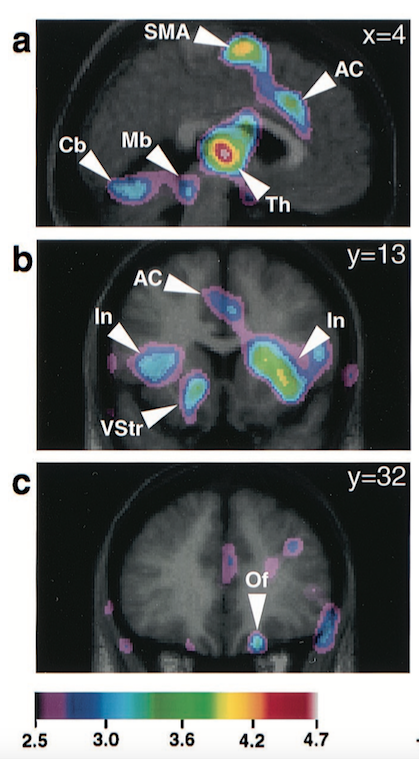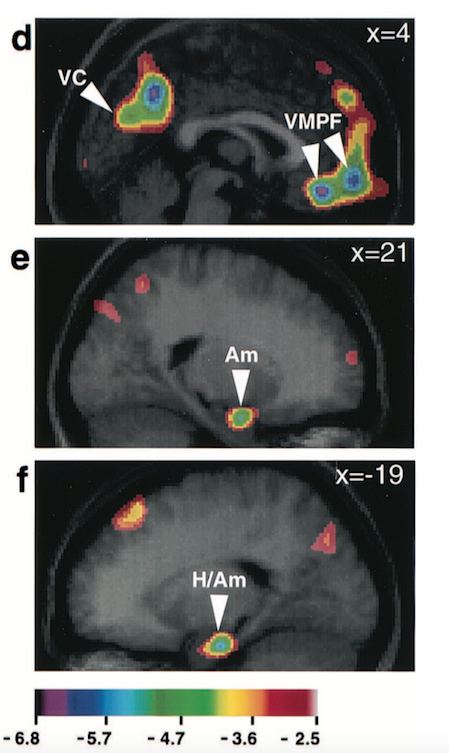Title of paper under discussion
Intensely pleasurable responses to music correlate with activity in brain regions implicated in reward and emotion
Authors
Anne J. Blood and Robert J. Zatorre
Journal
PNAS, 25 September 2001, vol 98 no 20, pp 11818-11823
Link to paper (free access)
Overview
Using a scanning technique called positron emission tomography (PET) to detect changes in blood flow to different regions of the brain whilst listening to music, Anne Blood and Robert Zatorre, researchers from Montreal Neurological Institute, set out to investigate the neural mechanisms underlying “intensely pleasant emotional responses to music”.
Participants in the experiment were asked to nominate classical music that gave them “shivers-down-the-spine” or “chills”. This music was then played to them whilst in the PET scanner, and all the while their heart rate, muscle activity, breathing, sweat and skin temperature were also monitored.
As the intensity of the “chills” increased there were changes in heart rate, muscle activity and breathing, as well as in blood flow through “brain regions thought to be involved in reward/motivation, emotion, and arousal” – in some regions blood flow increased, and in others it decreased.
These same brain areas are “known to be active in response to other euphoria-inducing stimuli, such as food, sex, and drugs of abuse”, meaning music appreciation shares brain circuitry with “biologically relevant, survival-related stimuli”.
Method
Chosen for declaring that they experience frequent, and reproducible, “chills” in response to certain pieces of music, 10 musicians (5 female and 5 male) were recruited for the study, all students at McGill University, Montreal.
Each participant “selected one piece of music that consistently elicited pleasant emotional responses, including chills”, choices including works such as the slow movement of Rachmaninov’s Third Piano Concerto and Barber’s Adagio for Strings. In addition to their “chills” choice each participant listened to an “emotionally neutral” music control piece. Each of these “music control” pieces was actually selected from the “chills” choices of other participants on the understanding that spine-tingles are listener specific – a piece that gives one person goosebumps will leave another cold.
(Using one person’s “chills” piece as another person’s “music control” piece was a clever sleight of hand in terms of experimental design – it meant that across all ten participants the scientists could study only the effect of “chills”, and rule out the effects of tempo, dynamic etc on listeners’ brains because in a group analysis these other effects then cancelled out).
Two more audio tracks were used as ‘baseline’ controls – 1) silence and 2) white noise that matched the loudness of the musical tracks.
(Using baseline controls as well as a music control meant the scientists could be sure that any observed decrease in blood flow was indeed a decrease from baseline, and not just the difference between “music control” and “chill”).
Each piece (“chills”, “music control”, “silence control” and “white noise control”) was listened to three times, with all twelve trials presented in a pseudo-random order. After each trial the participant was asked to rate their experience of “chills intensity” from 1 to 10, and during each trial various physiological measures (heart rate, muscle activity, breathing, sweat and skin temperature) were monitored.
Results
“Chills” music brought about the desired effect – spine tingles – in 77% of trials.
Heart rate, muscle activity and breathing increased significantly during the highest rated “chills” trials, but sweat and skin temperature showed no such increase.
Various brain regions exhibited increased blood flow as the “chills” rating increased:

Other brain regions exhibited decreased blood flow as the “chills” rating increased:

Discussion
All the brain circuitry identified above is known from previous studies to be key to reward/motivation, emotion and arousal. The pattern of increased blood flow to some regions and decreased flow to other regions may indicate “gating between behaviourally antagonistic ‘approach’ and ‘withdrawal ‘ systems”. For instance, “the amygdala (which saw decreased blood flow in response to “chills”) is known to be involved in fear and other aversive emotions” and the ventral striatum (which saw increased blood flow in response to “chills”) is “associated with reward and motivation/approach behaviour”.
By comparing the pattern of brain activation during intensely pleasurable music (pictured above) and brain activation during other “euphoria-inducing stimuli” the authors were keen to discover if music has its own pleasure circuits or rather if it shared them with other euphoria triggers. Time and again the comparisons showed the circuitry is shared, studies including:
- Cocaine
Cocaine administration in cocaine-dependent patients leads to increases in blood flow to the ventral striatum, midbrain, thalamus, insula and anterior cingulate cortex, and decreases in blood flow to the amygdala and ventral medial prefrontal cortex – a pattern that very closely mirrors the findings above. The decrease in amygdala blood flow in cocaine experiments is associated with “craving” rather than “rush”, suggesting that in this music study it may be in anticipation of the “chills” rather than the “chills” themselves.
- Chocolate
“The pleasant experience of chocolate consumption in humans has been found to be correlated with activity in midbrain, insula, the subcallosal region, and orbitofrontal cortex” – again mirroring musically-induced “chills” brain activity.
- Food and sex
Activity in the ventral striatum and/or the midbrain “appears to be the common mechanism underlying reward response to all naturally rewarding stimuli (e.g., food and sex)”. Such circuitry involves dopamine and endogenous opioids as mediators in the response.
Coda
Rachmaninov’s Piano Concerto No. 3 in D Minor, Opus 30
[10:15 – Intermezzo Adagio]
Piano – Sergei Rachmaninov, with Philadelphia Orchestra, cond. Ormandy
I have some smartarsy comments about the things we used to enjoy at school and how this study correlates. But mostly I’m concerned at lack of testing brains of the 10 musicians whilst they partook of coke, chocolate, food and sex. Surely that would give a more accurate set of results. I will just have to go and experiment for myself.
We still await your results Susi, has the funding not come through?